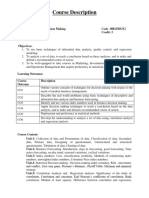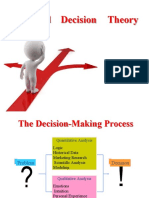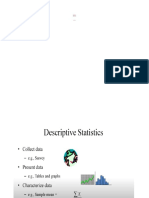3 0 0 3 Course Objectives: Introduction of Statistics
3 0 0 3 Course Objectives: Introduction of Statistics
Uploaded by
amritaCopyright:
Available Formats
3 0 0 3 Course Objectives: Introduction of Statistics
3 0 0 3 Course Objectives: Introduction of Statistics
Uploaded by
amritaOriginal Title
Copyright
Available Formats
Share this document
Did you find this document useful?
Is this content inappropriate?
Copyright:
Available Formats
3 0 0 3 Course Objectives: Introduction of Statistics
3 0 0 3 Course Objectives: Introduction of Statistics
Uploaded by
amritaCopyright:
Available Formats
Name of The Statistics I
Course
Course Code DBAD3002
Prerequisite Basics of statistics
Co-requisite
Anti-requisite
L T P C
3 0 0 3
Course Objectives
This course will introduce students to basic statistical methods, with a focus on the
understanding and knowledge of these methods to the business world. Students should be able
to apply basic statistical techniques and methods for grouping, tabular and graphical display
and interpretation of statistical data.
Course Outcomes
CO1 To describe the basic concepts of Statistics and types of data (K1).
To explain the basic concepts of measure of central tendency using presentation of data
CO2
(K2).
CO3 To understand the concept of measure of dispersion (K2)
CO4 To explain the basic concept of Skewness, kurtosis and time series (K1, K2)
CO5 To understand correlation and regression coefficients and relationship between them (K2)
CO6 To apply MS Excel tools to learn statistical concepts. (K3)
Continuous Assessment Pattern
Internal Assessment (IA) Mid Term Exam (MTE) End Term Exam (ETE) Total Marks
30 20 50 100
Course Content:
Unit I: Introduction of Statistics (7 lecture hours)
Origin, development, definition, scope, uses and limitations. Types of Data: Qualitative and
quantitative data, nominal and ordinal data, cross sectional and time series data, discrete and
continuous data, frequency and non-frequency data. Collection and Scrutiny of Data: Collection of
primary and secondary data-its major sources including some government publications, scrutiny of
data for internal consistency and detection of errors of recording, classification and tabulation of data.
Unit II: Presentation of Data (7 lecture hours)
Diagrammatic and graphical presentation of grouped data; graphing the data constructing
histograms, frequency polygon, frequency curve and ogives. Measures of Central Tendency
and Location: Mean, median, mode, partition values-quartiles, deciles, percentiles.
Unit III: Measure of Dispersion (9 lecture hours)
Absolute and relative measures of range, quartile deviation, Mean deviation, standard
deviation, variance of the combined series, Coefficient of variation
Unit IV: Measures Shape Of The Distribution (6 lecture hours)
Concept of Skewness, kurtosis; Time Series – Introduction And Importance, Components Of
Time Series, least cost method, moving average method, Seasonal, Cyclical Study.
Unit V: Correlation and Regression (6 lecture hours)
Simple Correlation, correlation between two variables (grouped and ungrouped data); Karl
Pearson’s Coefficient of correlation; Rank Correlation; Regression: - Concept, regression lines,
Curve Fitting In Scatter Diagrams, Simple Linear Regression Equation, Coefficient Of
Determination (R-Squared), Difference Between Correlation And Regression.
Unit VI: Use of MS-Excel as Statistical Analysis tool (5 lecture hours)
Practice questions: Measure Central tendency, Measure of Dispersion, Measure of shape of
the Distribution, Correlation and Regression on MS-Excel.
Suggested Readings:
1. Business Statistics by Naval Bajpai. 2nd edition. Pearson Education. 2013
2. Business Statistics: For Contemporary Decision Making by Black, Ken: Wiley. 2010.
3. Business Statistics by N D Vohra; McGraw Hill
4. Fundamentals of Statistics by Goon, A.M., Gupta, M.K., and B. Das Gupta, Vol-I.
You might also like
- Project Ebooks at Global Green Books - Work Breakdown Structure and Responsibility Assignment MatrixDocument2 pagesProject Ebooks at Global Green Books - Work Breakdown Structure and Responsibility Assignment Matrixapi-561686395100% (1)
- 20230117032741premier Brochure Full - 2023-01 (January 17)Document8 pages20230117032741premier Brochure Full - 2023-01 (January 17)jadetorresNo ratings yet
- John TitorDocument532 pagesJohn TitorKentai-p Vocaloid-music100% (7)
- The Spirit of OpulenceDocument4 pagesThe Spirit of OpulenceRichmond Adjei AmpemNo ratings yet
- Lecture 1Document13 pagesLecture 1amritaNo ratings yet
- BT2018 Sem 3Document22 pagesBT2018 Sem 3Raajvir DeoraNo ratings yet
- 29 SyllabusMaster 29Document2 pages29 SyllabusMaster 29cumbasanjayNo ratings yet
- Descriptiv Minor1Document2 pagesDescriptiv Minor1Mirza MuneebNo ratings yet
- QMS 102 Course PlanDocument5 pagesQMS 102 Course Planofficialrrk06No ratings yet
- Data Analytics of DemandDocument8 pagesData Analytics of Demandsarthakbhoj06No ratings yet
- First Sem ImprovementDocument5 pagesFirst Sem Improvementbindubahuleyan911No ratings yet
- Business Statistic Handout Bba - Sem 2Document7 pagesBusiness Statistic Handout Bba - Sem 2hanirveshNo ratings yet
- Manipal University JaipurDocument8 pagesManipal University JaipurAatmaj SalunkeNo ratings yet
- Foundations of Data ScienceDocument139 pagesFoundations of Data ScienceJebin Bose SNo ratings yet
- Business Stastistics - PGDMDocument2 pagesBusiness Stastistics - PGDMDeepu SharmaNo ratings yet
- Data Decision and ManagersDocument22 pagesData Decision and ManagersRekhaNo ratings yet
- Course Outline MTS 102 - Introduction To Statistics Fall 2023 DR M. Massarrat Ali Khan RevisedDocument5 pagesCourse Outline MTS 102 - Introduction To Statistics Fall 2023 DR M. Massarrat Ali Khan Revisedwaleedimran2004No ratings yet
- Business Analytics For Decision Making: Chandigarh Group of Colleges, JhanjeriDocument48 pagesBusiness Analytics For Decision Making: Chandigarh Group of Colleges, JhanjeriSachin KirolaNo ratings yet
- CP - BTech AI Sem - IV - Stat Meth 2022-23Document11 pagesCP - BTech AI Sem - IV - Stat Meth 2022-23xx69dd69xxNo ratings yet
- CS5103 Lecture Plan - Fundamnetals of Data ScienceDocument2 pagesCS5103 Lecture Plan - Fundamnetals of Data ScienceNaniChinnuNo ratings yet
- Ahore Chool OF Conomics: Statistics I (SQA-101)Document8 pagesAhore Chool OF Conomics: Statistics I (SQA-101)Abubakr maybe not - 23 years agoNo ratings yet
- SyallabusDocument2 pagesSyallabusSiddiqullah IhsasNo ratings yet
- Department of Statistics B.Sc. (H) Statistics: Discipline Specific Core Course - 1: Descriptive StatisticsDocument25 pagesDepartment of Statistics B.Sc. (H) Statistics: Discipline Specific Core Course - 1: Descriptive StatisticsSurbhi ChaurasiaNo ratings yet
- New SyllabusDocument4 pagesNew SyllabushemavativdNo ratings yet
- C1ST230112T C1ST230112PDocument2 pagesC1ST230112T C1ST230112PRamesh PrasadNo ratings yet
- MAT1015Document3 pagesMAT1015ms harshithaNo ratings yet
- Syllabus MATH 009Document2 pagesSyllabus MATH 009Pantalunan Garry100% (1)
- PM-ASDS Final Syllabus - 2019-2021Document19 pagesPM-ASDS Final Syllabus - 2019-2021M Masrur IkramNo ratings yet
- University of Zimbabwe Faculty of Commerce Business Studies Department Second SemesterDocument4 pagesUniversity of Zimbabwe Faculty of Commerce Business Studies Department Second SemesterchavoNo ratings yet
- Lec1 - Data and InformationDocument37 pagesLec1 - Data and InformationAlan SerranoNo ratings yet
- Week 2 NotesDocument11 pagesWeek 2 NotesceceliahofNo ratings yet
- B.Tech - B.Des SyllabusDocument110 pagesB.Tech - B.Des Syllabusnsinghrawat29No ratings yet
- Welcome: To All MBA StudentsDocument60 pagesWelcome: To All MBA StudentsMandeep KumarNo ratings yet
- Business StatisticsDocument6 pagesBusiness StatisticsesebabiNo ratings yet
- H1 Physics - 8866 - 2013Document19 pagesH1 Physics - 8866 - 2013Deborah MalanumNo ratings yet
- Sos B.SC Course OutlineDocument44 pagesSos B.SC Course Outlineaswathynirmal13580No ratings yet
- Managerial STAT IDocument4 pagesManagerial STAT Ikasimhayat02No ratings yet
- 3rd SemDocument20 pages3rd Semfarazali743125No ratings yet
- Mathematics - IIIA: (Numerical Analysis, Complex Analysis and Probability and Statistics)Document51 pagesMathematics - IIIA: (Numerical Analysis, Complex Analysis and Probability and Statistics)sarojpapuNo ratings yet
- UG Syllabus (GE) STAT W.E.F 2020-21 - 15.09.2021-Pages-49-57-1Document9 pagesUG Syllabus (GE) STAT W.E.F 2020-21 - 15.09.2021-Pages-49-57-1Pallavi TiwariNo ratings yet
- Syllabus: International Institute of Professional Studies Devi Ahilya University, IndoreDocument8 pagesSyllabus: International Institute of Professional Studies Devi Ahilya University, IndoreKavish SharmaNo ratings yet
- Indian Institute of Foreign Trade, Kakinada Program Name and Batch: BBA (FT) 2022-25 Course Name: Introductory StatisticsDocument5 pagesIndian Institute of Foreign Trade, Kakinada Program Name and Batch: BBA (FT) 2022-25 Course Name: Introductory Statisticsvaibhav guptaNo ratings yet
- Statistics Sem 2Document21 pagesStatistics Sem 2shruti JainNo ratings yet
- SEC - Statistics For BussDocument1 pageSEC - Statistics For Bussdestroyergaming2000okNo ratings yet
- 21AML543 - Fundamentals of Data ScienceDocument4 pages21AML543 - Fundamentals of Data SciencehemavativdNo ratings yet
- Curriculum and Syllabus For B.tech 1st SemDocument25 pagesCurriculum and Syllabus For B.tech 1st SemErric FanshionNo ratings yet
- 1302019111943856 (5).docDocument4 pages1302019111943856 (5).docSheetal KumariNo ratings yet
- Unit-32 Tabulation and Graphic Presentation - Case Studies PDFDocument10 pagesUnit-32 Tabulation and Graphic Presentation - Case Studies PDFRAJESH165561No ratings yet
- M I B A: Q A QA: Ronald T. Chua (RTC) and Enrico C. Angtuaco (ECA)Document5 pagesM I B A: Q A QA: Ronald T. Chua (RTC) and Enrico C. Angtuaco (ECA)Yatheender P.MNo ratings yet
- 1060 FileDocument232 pages1060 FileNishant KumarNo ratings yet
- Ambedkar University Delhi, Kashmere Gate: Content: What Is This Course About?Document2 pagesAmbedkar University Delhi, Kashmere Gate: Content: What Is This Course About?SamuelAugustinNo ratings yet
- Example of A Maths Unit PlanDocument5 pagesExample of A Maths Unit Plantahaj81296No ratings yet
- BSC Statistics (H) Sem LV Syllabus DUDocument8 pagesBSC Statistics (H) Sem LV Syllabus DUabsolutelyshii213No ratings yet
- Course Report: Master Complete Statistics For Computer Science - IDocument2 pagesCourse Report: Master Complete Statistics For Computer Science - ISufyan AkbarNo ratings yet
- Combining SSM and DEA: Evaluating The Basic Research Performance of The Chinese Academy of SciencesDocument26 pagesCombining SSM and DEA: Evaluating The Basic Research Performance of The Chinese Academy of SciencesjozeluizNo ratings yet
- Maths Syllabus (6th Sem)Document2 pagesMaths Syllabus (6th Sem)tegevi9289No ratings yet
- STAT 100 - Data Science IDocument2 pagesSTAT 100 - Data Science IRaj TiwariNo ratings yet
- Business StatisticsDocument3 pagesBusiness StatisticsIsaac Jabu StandNo ratings yet
- 3.b.tech ME 3rd Sem Syllabus UEMJ-1Document18 pages3.b.tech ME 3rd Sem Syllabus UEMJ-1Saswat SharmaNo ratings yet
- E - TC and Elex - Syllabus - 4102017 PDFDocument3 pagesE - TC and Elex - Syllabus - 4102017 PDFMukesh KatoleNo ratings yet
- Indian Institue of Technology 1Document67 pagesIndian Institue of Technology 1venkatasaivishwesvarNo ratings yet
- CS-2001 - Data Structures-BS-DS - Fall-2021Document6 pagesCS-2001 - Data Structures-BS-DS - Fall-2021Muhammad AhmedNo ratings yet
- Business Strategy MbaDocument1 pageBusiness Strategy MbaamritaNo ratings yet
- Operations Research Bba Set 2Document2 pagesOperations Research Bba Set 2amritaNo ratings yet
- Dbad3002 Lesson Plan Report RF CampusDocument6 pagesDbad3002 Lesson Plan Report RF CampusamritaNo ratings yet
- What Is Data WarehouseDocument19 pagesWhat Is Data WarehouseamritaNo ratings yet
- Data Warehouse - Dimensional Modelling - Use Case Study: EwalletDocument7 pagesData Warehouse - Dimensional Modelling - Use Case Study: EwalletamritaNo ratings yet
- Teaching Notes of RDocument78 pagesTeaching Notes of RamritaNo ratings yet
- Decision Modeling Using SpreadsheetDocument36 pagesDecision Modeling Using SpreadsheetamritaNo ratings yet
- Chap02 Decision Modelling Using SpreadsheetDocument36 pagesChap02 Decision Modelling Using SpreadsheetamritaNo ratings yet
- Decision Making Under UncertaintyDocument13 pagesDecision Making Under UncertaintyamritaNo ratings yet
- Continuous Improvement Toolkit: Probability DistributionsDocument25 pagesContinuous Improvement Toolkit: Probability DistributionsamritaNo ratings yet
- Lecture 2Document19 pagesLecture 2amritaNo ratings yet
- Practice SetDocument4 pagesPractice SetamritaNo ratings yet
- Moot CourtDocument18 pagesMoot CourtBava EnkayNo ratings yet
- Cha Guevara PPT - 144Document11 pagesCha Guevara PPT - 144Abdullah MehediNo ratings yet
- Making Sense of Market IntelligenceDocument13 pagesMaking Sense of Market IntelligenceAida ArguetaNo ratings yet
- HJKKGGGDocument94 pagesHJKKGGGSushanta100% (1)
- Chapter 3 Units of Measurement and ApplicationDocument30 pagesChapter 3 Units of Measurement and ApplicationAaron KirkNo ratings yet
- Authentic Materials in English As A Second Language ConversationDocument92 pagesAuthentic Materials in English As A Second Language ConversationVanne CandoNo ratings yet
- Management of Blood Donors and Blood Donations From Individuals Found To Have A Positive Direct Antiglobulin TestDocument11 pagesManagement of Blood Donors and Blood Donations From Individuals Found To Have A Positive Direct Antiglobulin TestLuis Enrique Tinoco JuradoNo ratings yet
- A Source Book KrishnaDocument590 pagesA Source Book KrishnaSubhankar Bose75% (8)
- 8086 InstructionsDocument25 pages8086 Instructionsxkurt358792No ratings yet
- Funda NewDocument8 pagesFunda NewSourav SutradharNo ratings yet
- Saladin and The Saracens (PDFDrive)Document51 pagesSaladin and The Saracens (PDFDrive)K horne100% (2)
- CCNA 2 Chapter 4 v5.0 Exam Answers 2015 100Document8 pagesCCNA 2 Chapter 4 v5.0 Exam Answers 2015 100ovidiu0702No ratings yet
- Alessio Plebe, Giorgio Grasso - The Unbearable Shallow Understanding of Deep LearningDocument39 pagesAlessio Plebe, Giorgio Grasso - The Unbearable Shallow Understanding of Deep LearningJOSÉ RODRIGO GARCÍA GONZALESNo ratings yet
- Conceptual Selling OverviewDocument2 pagesConceptual Selling OverviewAlexandra BuradaNo ratings yet
- DLL - English 3 - Q1 - W1Document3 pagesDLL - English 3 - Q1 - W1cristina de diosNo ratings yet
- Minerals and Rocks Test ReviewDocument4 pagesMinerals and Rocks Test ReviewIerdna RamosNo ratings yet
- Final Exam - Basic 3 - Ciunac - Johan CruzDocument5 pagesFinal Exam - Basic 3 - Ciunac - Johan CruzJohan CruzNo ratings yet
- Biology: The Science of Life: Prepared By: Mrs. Ethel O. Cueto, RNDDocument14 pagesBiology: The Science of Life: Prepared By: Mrs. Ethel O. Cueto, RNDnikki abalosNo ratings yet
- Intensive Writing Meeting 9 Process EssayDocument20 pagesIntensive Writing Meeting 9 Process Essayestu kaniraNo ratings yet
- 清末民初国民意识生成与嬗变的历史考察 林红玲Document181 pages清末民初国民意识生成与嬗变的历史考察 林红玲迪 何No ratings yet
- ProofreadDocument2 pagesProofreadapi-215636357No ratings yet
- Dialogue Expressions of Asking and Giving OpinionDocument6 pagesDialogue Expressions of Asking and Giving OpinionJose miguel Sanchez gutierrezNo ratings yet
- PROJECT PROPOSAL For Income Generating Projects in EPPDocument3 pagesPROJECT PROPOSAL For Income Generating Projects in EPPvincevillamora2k1188% (16)
- Shodhganga Thesis in HindiDocument4 pagesShodhganga Thesis in HindiPaperWriterServicesWashington100% (1)
- Modulo 4 - A EngDocument20 pagesModulo 4 - A EngCARLA CASASNo ratings yet
- Ujian Sumatif 1 Ting 1 2017Document8 pagesUjian Sumatif 1 Ting 1 2017jayweinxNo ratings yet





































































































